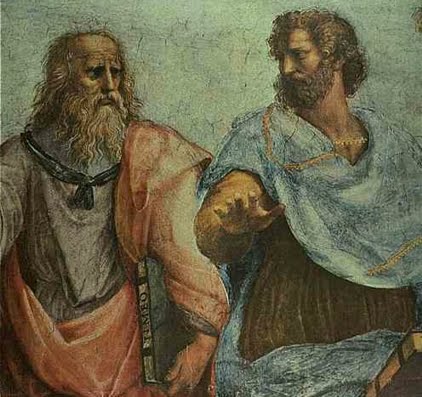In Western Europe, the states which emerged after the collapse of the Roman Empire in the West were backward with regard to scientific and philosophical inquiry. In the Roman Empire, the language of science and philosophy had been Greek. While the elites of the Roman Empire had read the classical Greek authors in Greek, the collapse of the Roman Empire in the West led to a decline of the number of people who were able to read Greek. A few works by Greek classical authors — e.g. some of Aristotle’s logical works and parts of the dialogue Timaeus by Plato — had already been available in Latin translation. For many other works Latin translations would have been needed, but these were rare for a long time.
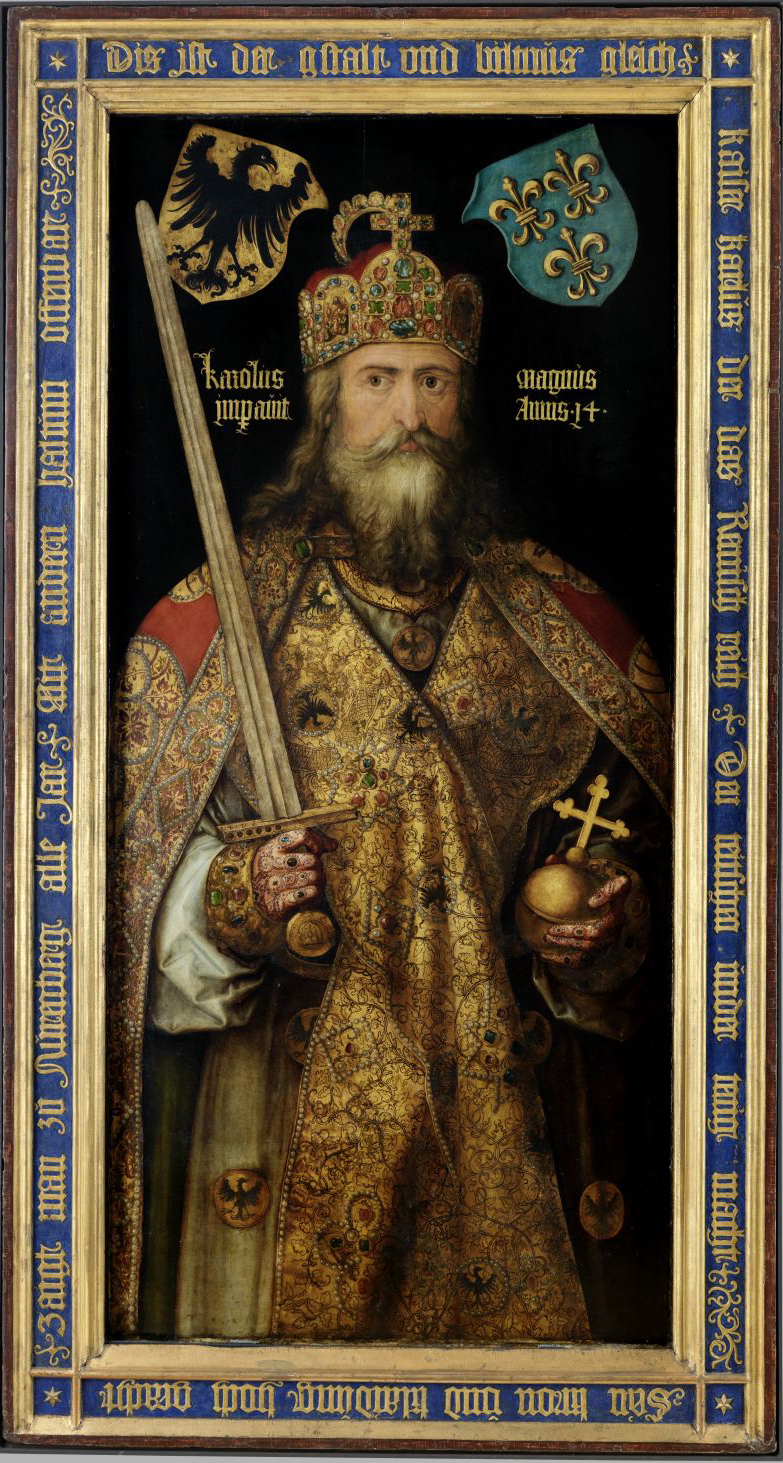
Painting by Dürer, 1511-13
One of the first signs of an intellectual recovery was the determined effort by Frankish King Charles I (later Emperor Charlemagne) in the 8th century to support elementary education in his Empire. Schooling at monasteries and at schools associated with cathedrals — the “cathedral schools” — was started and by the 11th century Western Europe was on its way to catch up.
The curriculum taught in these schools were the “seven liberal arts”: the trivium, consisting of grammar, rhetoric and logic, and the quadrivium, consisting of arithmetic, geometry, astronomy and music (Grant, 2011, p. 14).
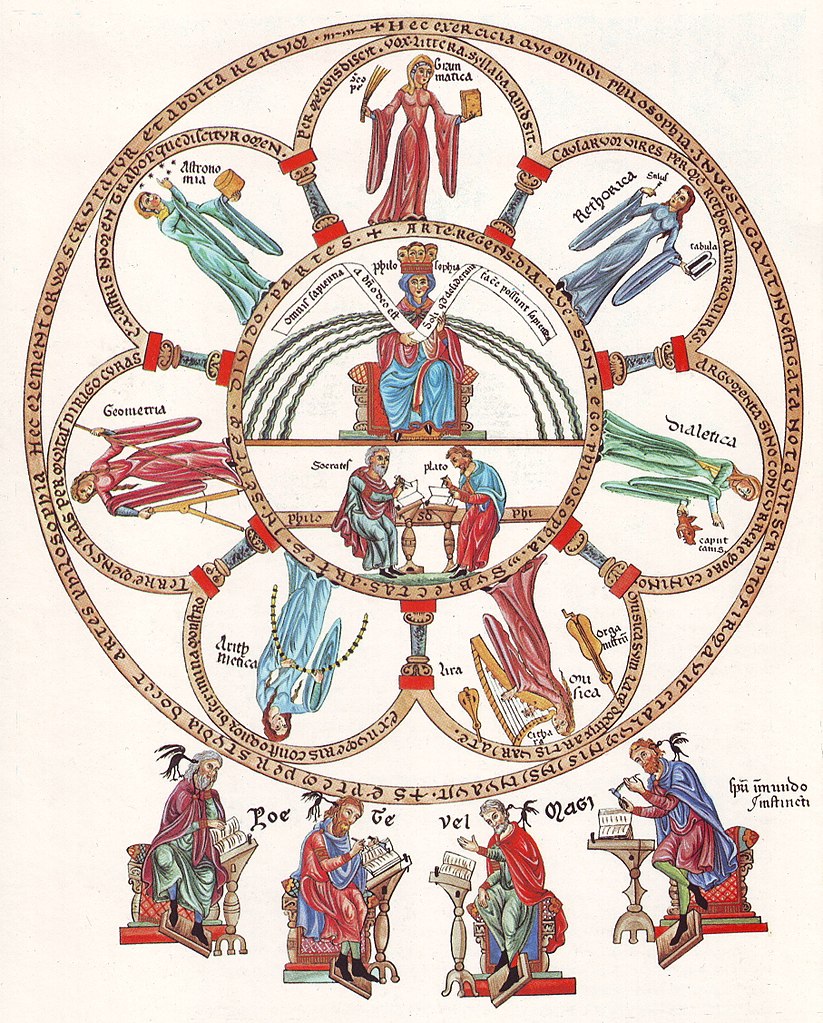
In the Hortus deliciarum, 1167.
Natural philosophy and education
European intellectual life in the 12th century experienced an upswing which now many call the “12th century Renaissance”. Rationalistic thinking and analysis became more valued. David C. Lindberg writes:
[T]he urban schools, like European society more generally, saw a marked “rationalistic” turn—that is an attempt to apply intellect and reason to many areas of human enterprise … [C]onfidence in human intellectual capacity pervaded the schools, where philosophical method was applied with increasing zeal to the whole of the curriculum, including biblical studies and theology.
Lindberg, 2007, p. 206
Another important feature of intellectual life in the 12th century was a kind of naturalism: the idea that God created the world, together with the laws of nature, but after that he left it more or less alone. After its creation, the world continued to work according to cause-effect relationships in nature. These causal relationships can be relied upon as permanent and can be understood by natural philosophers and scientists—an idea important as a precondition of scientific activity. Thierry of Chartres and William of Conches—both of them teachers at the cathedral school of Chartres—were prominent representatives of this naturalistic philosophy.
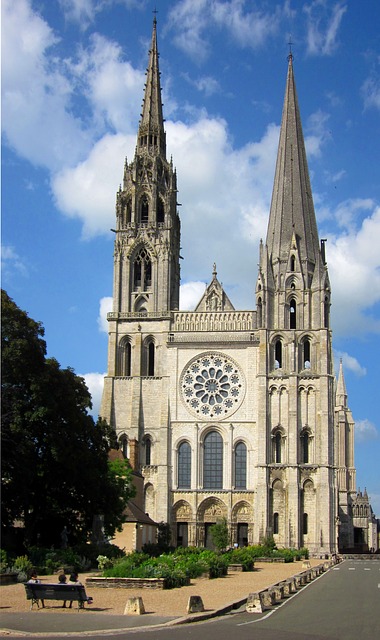
The first universities appeared already in the 11th century in Bologna, Italy and Oxford, England, followed by the University of Paris in the 12th century. Teaching at Bologna was focused on law, but in Oxford and Paris the curriculum was broader. In Paris the University had four faculties: Arts, Medicine, Law and Theology. “Arts” meant the “liberal arts” as mentioned above. Studying these “arts” was a prerequisite for studying Medicine, Law or Theology.
The translations
European scholars and churchmen were often on the search for books from classical Greece and Rome and more and more books and writings were translated into Latin.
As Sylvain Gouguenheim showed in his book Aristote au Mont Saint-Michel. Les racines grecques de L’Europe chrétienne, translation of Aristotle from Greek to Latin started already in the early 12th century (Gouguenheim, 2008). Even earlier, when the Normans conquered Sicily from the Arabs in 1091, books written in Greek — for example medical textbooks — became available and were translated into Latin.
However, many of the writings of the classical authors reached Western Europe via Arabic translations. These started to become available in the 11th and 12 centuries, after Christians re-conquered parts of Muslim Spain. These Arabic translations of classical works were translated into Latin by Christian scholars like Gerard of Cremona (d. 1187), who had learned Arabic in Spain. He alone has translated more than 60 books from Arabic to Latin, among them medical works from Galen, Euclid’s Elements, Ptolemy’s Almagest and many writings by Aristotle. Original works of Islamic authors like Avicenna, Rhazes and al-Khwarizmi were also translated (Grant, 2011, p. 24; Hannam, 2009, p. 70).
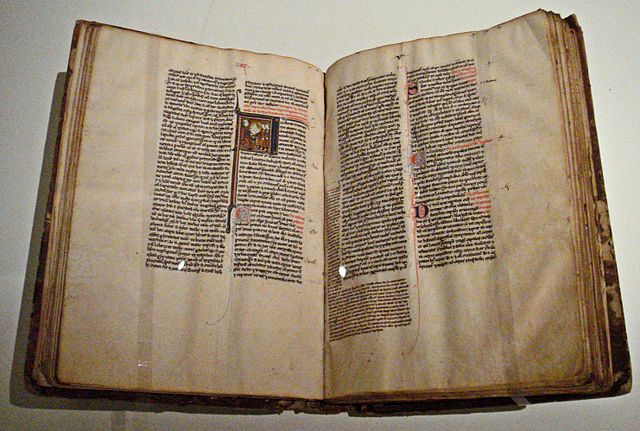
Translated by Gerard of Cremona from the Arabic during the latter half of the 12th century
Though the translations from Arabic to Latin — in particular of Aristotle’s works and of Arabic commentaries on them — were important for the revival of intellectual life in Western Europe, direct Greek to Latin translations of his works were far more numerous than those made from Arabic (Grant, 2011, p. 26). They were also nearer to the original texts because Arabic (plus, sometimes, Syriac) wasn’t there as an intermediary language.
Medieval scholars, the readers of the translations, preferred the Greek-to-Latin translations.
Grant, 2011, p. 26
Parallels with the Islamic translation movement
As shown above, there are some interesting parallels in the development of Islam and of Western European Christianity during the early Middle Ages: the beginnings were similarly unpromising: both the conquering Arabs and the Germanic kingdoms ruling Western Europe after the fall of the Roman Empire in the West were culturally backward as compared to the Greco-Roman civilization. Sophisticated philosophical and scientific development took off — first in areas ruled by Islam and later in Western Europe — after these cultures started to translate and to absorb the writings of ancient Greek and Greco-Roman authors. In both cultures, a huge effort was exerted to translate works of these authors.
The large scale Islamic translation movement started 2-3 centuries earlier than the European translation movement. By the time Europeans started their translation movement, the Islamic translation movement was more or less ended.
Aristotle’s influence
Up to the large scale translations, started in the 12th century, Europe was very much influenced by Plato and Neoplatonism. .
However, by the mid-13th century, almost all works of Aristotle were translated to Latin. As soon as such translations became widespread, Western Europe’s new universities — many of them established already in the 12th and 13th centuries — started teaching Aristotle’s writings, and this gained a central place at the universities.
This development was significant because much of Aristotle’s writings had to do with natural philosophy. Steven Weinberg writes:
Aristotle’s writings were naturalistic in a way Plato’s were not, and his vision of a cosmos governed by laws, even laws as ill-developed as his were, presented an image of God’s hands in chain.
Weinberg, 2016, p. 127
Thus, the naturalistic tendencies which were present already in the 12th century in schools like the school of Chartres (see above) received a huge boost by the introduction of Aristotle’s writings into European intellectual life. The idea that nature had its own laws which — except for occasional miracles — determined events in the world received a great support by these writings.
Many of the scholars influenced by Aristotle were theologians and often belonged to mendicant orders, like Albertus Magnus and Thomas Aquinas, both of whom were Dominican friars and taught at the University of Paris.
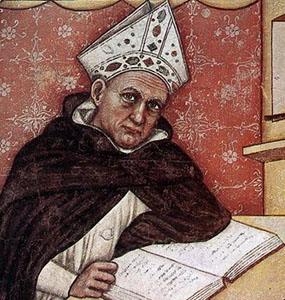
Many of Aristotle’s ideas — like the idea that the world was eternal — were theologically relevant and were criticized based on Christian doctrine. However, many other of his ideas, like his ideas on motion or the characteristics of natural objects, were less relevant in that way. Nonetheless, they were discussed by these scholars. For example, Albertus favored Ptolemaic ideas about the universe over Aristotle’s spheres, and Thomas disagreed with Aristotle on motion: in contrast to Aristotle, he thought that in vacuum motion would take a finite amount of time.
Many other cleric scholars in the 13th century, like Jean Buridan, Nicholas Oresme, Robert Grosseteste and Roger Bacon debated Aristotle’s ideas along these lines. Some — in particular a group of scholars at Merton College at Oxford, the “Merton Calculators”, who worked there during the first half of the 14th century — even used mathematics to describe motion.
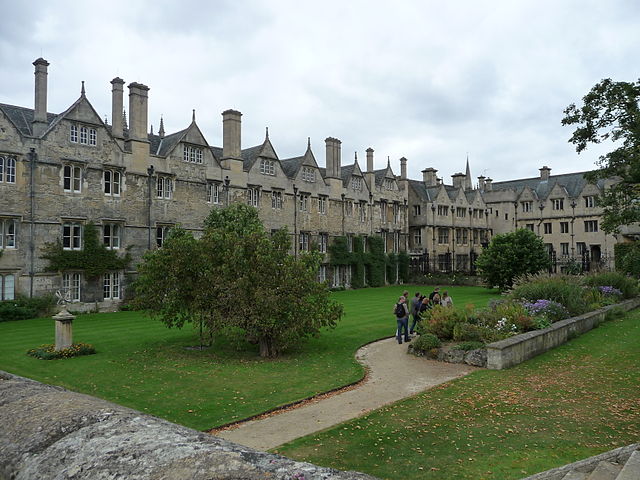
Thus, just as in regions ruled by Islam, Aristotle has a huge influence on intellectual life in Europe. His writings provided, for the first time in Medieval Europe, a large store of ideas about the world, to be discussed, debated and criticized by scholars.
The enthusiasm shown towards Aristotle’s writings was not shared by everyone in Europe. Influential people within the Catholic church tried to limit Aristotle’s influence. More about this in a later Part of this series.
Literature
Gouguenheim, S. (2008). Aristote au Mont Saint-Michel. Les racines grecques de L’Europe chrétienne. Paris: Éditions du Seuil.
Grant, E. (2011). The Foundation of Modern Science in the Middle Ages. Their Religious, Institutional and Intellectual Contexts. Cambridge: Cambridge University Press.
Hannam, J. (2009). God’s Philosophers: How the Medieval World Laid the Foundations of Modern Science. London: Icon Books.
Lindberg, D. C. (2007). The Beginnings of Western Science. The European Scientific Tradition in Philosophical, Religious, and Institutional Context, Prehistory to A.D. 1450. Second Edition. Chicago: The University of Chicago Press.
Weinberg, S. (2016). To Explain the World: The Discovery of Modern Science. New York: Harper Perennial.
To be continued.
